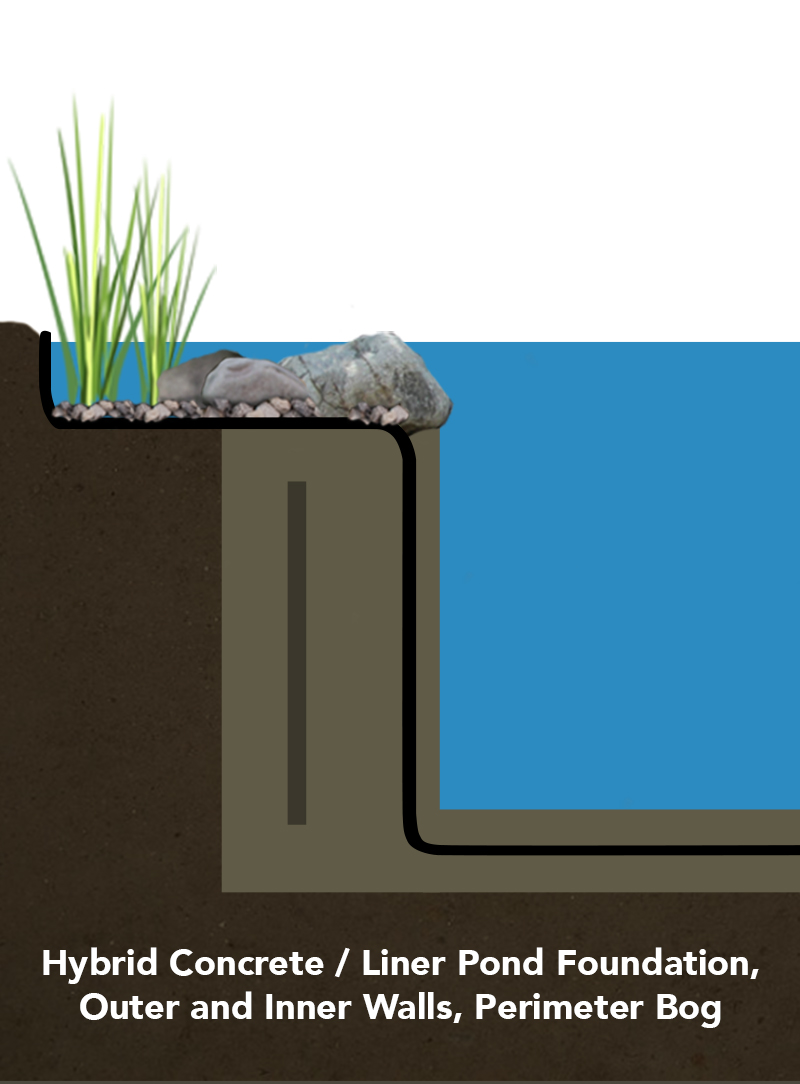Natural Filtration 301 Chapter 3
Perimeter Bog

One of the simplest Passive Bog Filters is the Perimeter Bog, a shallow, flooded, planted area at the edge of the pond where water is simply in contact with the medium that the plants are in. The planting medium is often ¼” to 3/4” round gravel, that allows water easy passage through the bed when clean, but can be crushed stone, clay, sand or even peat. Passive bogs become less efficient as plants get farther from the pond – root masses immediately adjacent to the water block the penetration of water and nutrients farther in from the water’s edge – so long, narrow, shallow perimeter bogs function best. An easy way to create them in lined ponds is to widen the “Rock Shelf”, the first shelf along the pond’s edge around 8” deep that the coping rock are set on, to accommodate a shallow gravel bed behind no more than about 3’wide. Stones dry-set just at or below water level on the pondside edge of the shelf keep the gravel from falling into the pond while allowing water into the gravel bed. (See College of Construction, Ponds 101, Chapters 9 and 10)

VERY IMPORTANT! There have to be nutrients in the water or the bog will not thrive! It’s that Circle of Life thing – fish, plants, bacteria. Kickstart the cycle by leaving the bog plants in the soil they were planted in when you place them in the gravel – remove the pot but add no additional soil. That will get the plants started while they adapt to their new nutrient source.

One of the simplest Passive Bog Filters is the Perimeter Bog, a shallow, flooded, planted area at the edge of the pond where water is simply in contact with the medium that the plants are in. The planting medium is often ¼” to 3/4” round gravel, that allows water easy passage through the bed when clean, but can be crushed stone, clay, sand or even peat. Passive bogs become less efficient as plants get farther from the pond – root masses immediately adjacent to the water block the penetration of water and nutrients farther in from the water’s edge – so long, narrow, shallow perimeter bogs function best. An easy way to create them in lined ponds is to widen the “Rock Shelf”, the first shelf along the pond’s edge around 8” deep that the coping rock are set on, to accommodate a shallow gravel bed behind no more than about 3’wide. Stones dry-set just at or below water level on the pondside edge of the shelf keep the gravel from falling into the pond while allowing water into the gravel bed. (See College of Construction, Ponds 101, Chapters 9 and 10)

VERY IMPORTANT! There have to be nutrients in the water or the bog will not thrive! It’s that Circle of Life thing – fish, plants, bacteria. Kickstart the cycle by leaving the bog plants in the soil they were planted in when you place them in the gravel – remove the pot but add no additional soil. That will get the plants started while they adapt to their new nutrient source.




